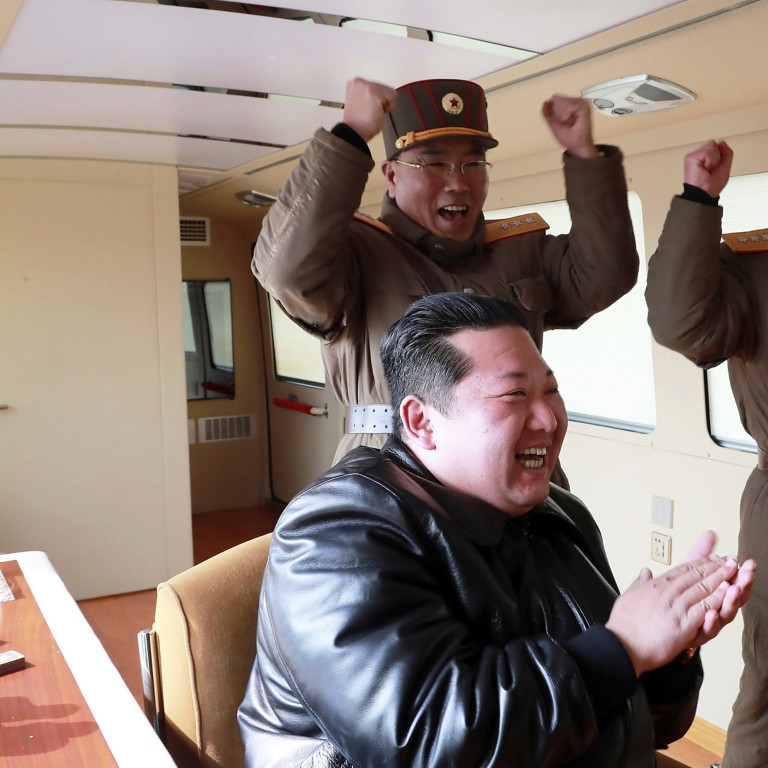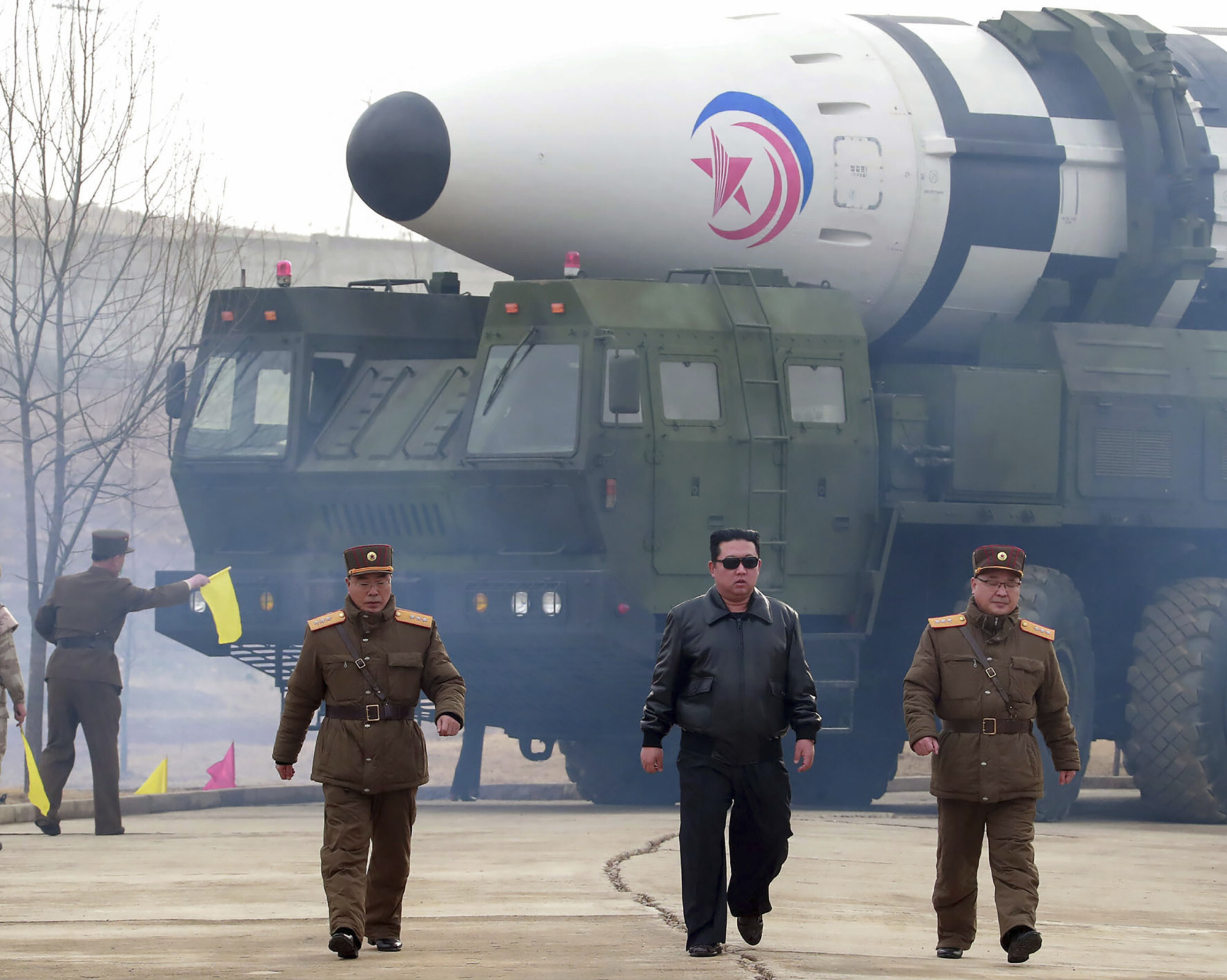
Kim Jong-un oversees launch of new ICBM dubbed ‘monster missile’ as crisis brews on Korean peninsula
- The Hwasong-17 fell in waters off Japan but showed a capability to carry a payload that could reach Washington, New York or Chicago, said a rocket science expert
- Analysts believe there will be more launches – including a missile that will fly over Japan – as US-China rivalry and the Ukraine war intensify
He toured the launch site and shouted “Fire!” before the rocket flew to an altitude of 6,200km and fell 1,090km away in waters off Japan, KCNA said.
North Korea suspected missile explodes in mid-air after launch
The projectile, launched at a steep angle from the Sunan airfield in Pyongyang, had a higher altitude than its previously tested long-range missiles.
Analysts said if the missile had been fired at a normal angle, it could have flown as far as 13,000km, reaching the eastern coast of the US.
That’s higher and farther than the Hwasong-15 ICBM, which in 2017 flew 960km and reached a top altitude of over 4,500km.

Dubbed a “monster” missile for its size, the Hwasong 17 – which was showcased at an October 2020 military parade – is thought to carry multiple warheads and have a range exceeding 13,000km, making it one of the world’s biggest ICBMs.
In response to Pyongyang’s launch, Seoul fired a series of missiles from ground, sea and air to “verify its ability to strike the North’s missile launch sites and its military command and control facilities”, the South’s Joint Chiefs of Staff said.
South Koreans worry Ukraine crisis will slow North Korean denuclearisation
“What the North showed on Thursday is its capability to carry a tonne of payload over some 12,500-13,000km to reach Washington, New York or Chicago,” said Chang Young-keun, a rocket science expert at the Korea Aerospace University.
“But the North has not yet proven that it has acquired various advanced technologies including those needed for atmospheric re-entry and flight at extreme velocities for ICBMs loaded with multiple warheads.”
To achieve that, the ICBM would launch at a normal trajectory and land in the Pacific near Hawaii or Guam, prompting the US to intercept it, Chang added.
“This would spark a war,” he said.
Chang, however, said the new test was rather aimed to build up nuclear arsenals to use them as a bargaining chip to press the US to engage in dialogue and get the sanctions lifted. Washington has repeatedly said it is willing to hold unconditional talks with Pyongyang.
The next step is likely to involve an ICBM launched at a normal angle to fly over Japan and splash into the Pacific Ocean
He said Kim is likely to ratchet up tensions by conducting a series of tests, including blasting off a military satellite from the Dongchang-ri launch site, firing “tactical” low-yield nuclear weapons and unveiling submarine-launched missiles.
Professor Yang Moo-jin at the University of North Korean Studies in Seoul said Thursday’s launch was also intended to test Yoon’s incoming government and put pressure on the US to change course in the run up to its November midterm elections.
“The North believes it would be difficult for the UN Security Council to come up with new sanctions in light of the current tensions between the US and its allies on one side and Russia and China on the other side,” Yang said.
He said “with the North having crossed the red line, tensions on the Korean peninsula will keep rising until mid-April” when Washington and Seoul are expected to hold their annual military drills.
The security situation could improve in May when US President Joe Biden visits South Korea for a summit with Yoon, Yang added.

Harry J. Kazianis, senior director of Korean Studies at the Centre for the National Interest, said had Biden decided to make the North Korea issue a priority and not ignored its build-up of nuclear weapons technology, at least some measure of progress could have been made.
“Biden seems to have borrowed the policies of the Obama administration on North Korea: to demand Pyongyang come to the bargaining table and do nothing until that day comes,” Kazianis said.
Biden’s strategy also allowed Pyongyang to sell its nuclear weapons technology to countries like Iran, he said, adding “as history has shown, the US president’s policy will only guarantee Kim’s nuclear arsenal gets bigger and more advanced.”
Park Won-gon, a political-science professor at the Ewha Woman’s University, said Washington and Seoul would respond by expanding their military exercises to include movements of troops beyond computer simulations and the forward deployment of aircraft carriers and nuclear bombers in the western Pacific.
“The North believes time is ripe for it to make it an accomplished fact that it has acquired the status internationally as a nuclear-armed state,” Park said.
North Korea takes pictures from space in claimed spy satellite test
Although the US is occupied with the Ukraine war, Park feared the escalating situation on the Korean peninsula region “could bring 2017’s fire and fury back or possibly worse.”
Meanwhile, Ryu Sung-yeop from the Korea Research Institute of Military Affairs said North Korea has much bigger plans.
“The next step is likely to involve an ICBM launched at a normal angle to fly over Japan and splash into the Pacific Ocean.
“This is expected to happen before April 15, the 110th birthday of the North’s founder Kim Il-sung.”
Lee Il-woo at the Korea Defence Network, a group of military experts, said “diplomacy has little room to work” as the region is being quickly drawn into the intensifying rivalry between the US-led Western bloc and a grouping comprising of China, Russia and North Korea.
Additional reporting by Bloomberg

